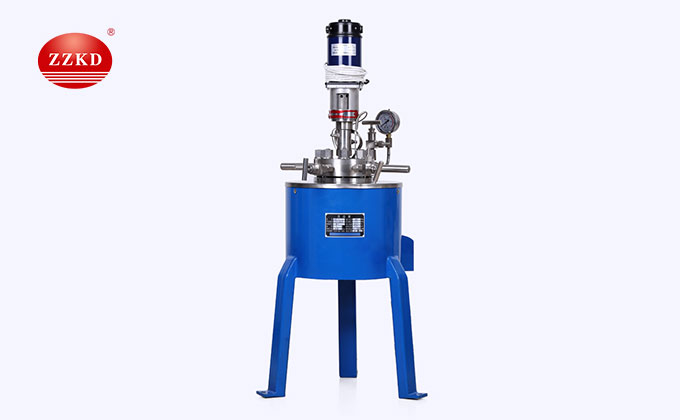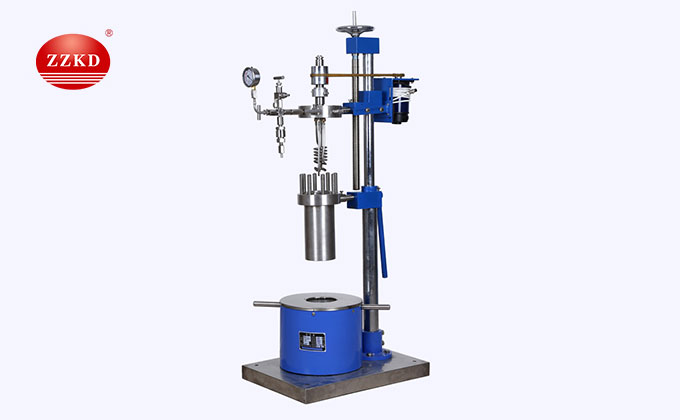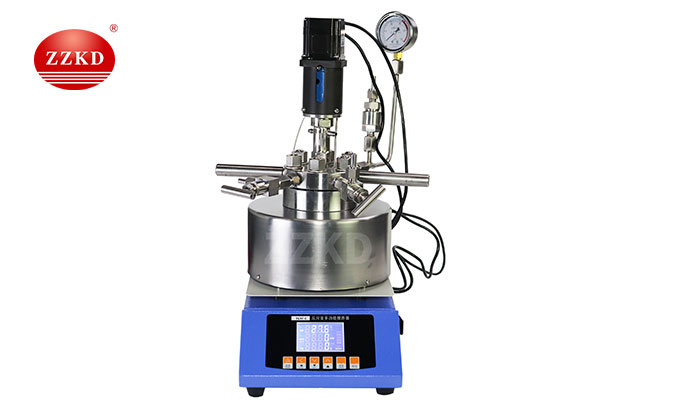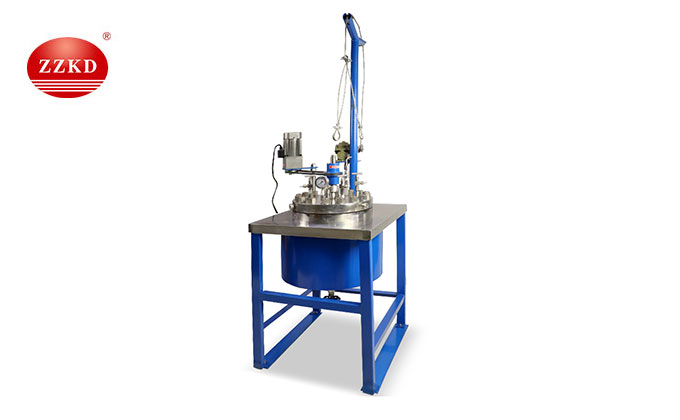The lab scale high pressure reactor is used for chemical, high-temperature and high-pressure synthetic reactions or catalytic reactions, and it is necessary to simultaneously measure pressure, temperature, measure speed and add inert gas protection, stabilize the pressure and realize the experimental environment under the conditions of on-line sampling or on-line feeding. . It is suitable for photochemical high-pressure reaction, carbon dioxide CO2 reduction, carbon dioxide CO2 reduction to methanol, carbon dioxide CO2 reduction to methane CH4, reduction and degradation of nitrogen oxides, high-pressure photocatalytic degradation of formaldehyde and other fields.
High pressure autoclave reactor is a typical innovation of magnetic transmission device applied to reaction equipment. It fundamentally solves the problem of shaft seal leakage that cannot be overcome by packing seals and mechanical seals before, without any leakage and pollution. The most ideal device for reaction, especially for chemical reactions with flammable, explosive and toxic media, shows its superiority even more.
Lab Scale High Pressure Reactor Model:
ZZKD Machinery has been focusing on the research and development and production of stainless steel reactors for many years. The lab scale high pressure reactor is one of our main products. changed a lot.
At present, we mainly have four types of high pressure autoclave reactors: FCF series lab scale high pressure reactors, CJF series high-pressure stirred autoclaves and simple lab scale high pressure reactors.
Lab Scale High Pressure Reactor Structure:
FCF Series Lab Scale High Pressure Reactor:
FCF series lab scale high pressure reactor is mainly composed of steering wheel, motor, air valve, vacuum gauge, kettle body cover, safety valve, heating device, controller and other components:
Kettle body cover: ensure that the medium and mixing parts are completely sealed
Vacuum gauge: real-time monitoring of the reaction pressure in the kettle
Safety valve: The reaction kettle is equipped with a safety valve, which has a fast exhaust speed and is safe and reliable.
Controller: intelligent digital temperature control meter with self-tuning function, automatic constant temperature control function, speed display and stepless speed regulation function.
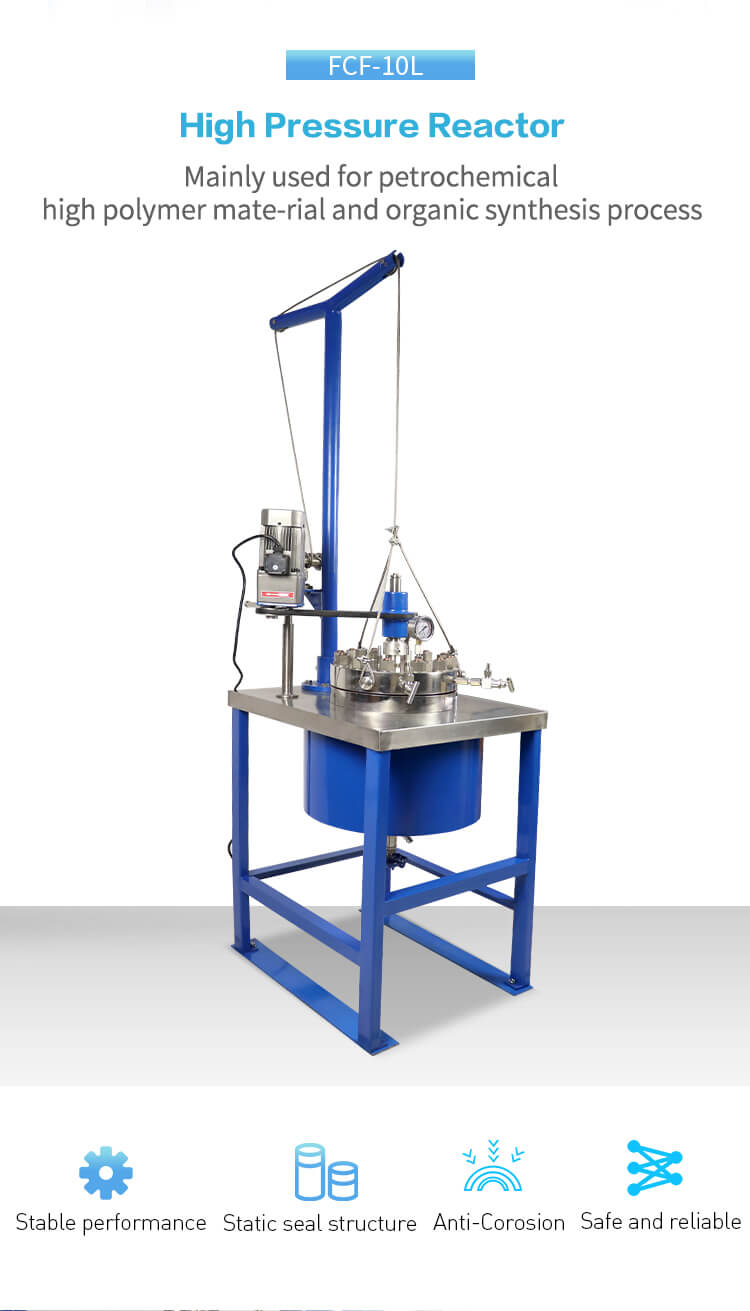
CJF Series Lab Scale High Pressure Reactor:
CJF series high pressure autoclave reactor is mainly composed of motor, stirring device, vacuum gauge, static seal, kettle cover, safety valve, kettle body, controller and other components:
Motor: high-power motor, powerful and stable performance
Stirring device: It adopts a static seal structure, and the stirrer and the motor drive are connected through magnetic coupling.
Vacuum gauge: real-time monitoring of the reaction pressure in the kettle
Safety valve: made of stainless steel, corrosion resistant
Controller: intelligent digital temperature control meter with self-tuning function, automatic constant temperature control function, speed display and stepless speed regulation function.
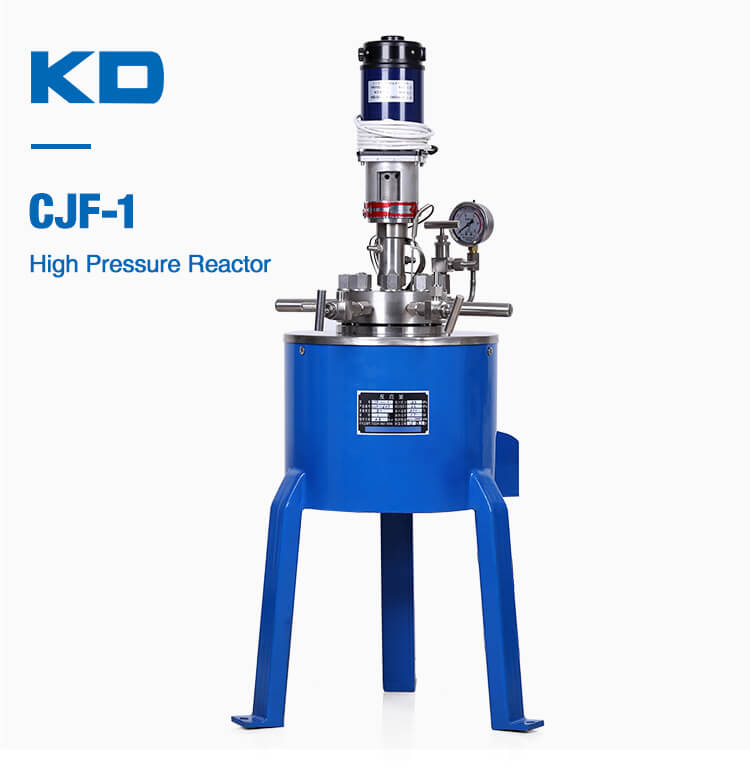
Simple Lab Scale High Pressure Reactor:
The simple high pressure autoclave reactor is mainly composed of kettle body cover, safety valve, pressure gauge, needle valve and other components:
Kettle body cover: ensure that the medium and mixing parts are completely sealed
Safety valve: The reaction kettle is equipped with a safety valve, which has a fast exhaust speed and is safe and reliable.
Pressure gauge: real-time monitoring of the reaction pressure in the kettle
Needle valve: Made of stainless steel, corrosion resistant
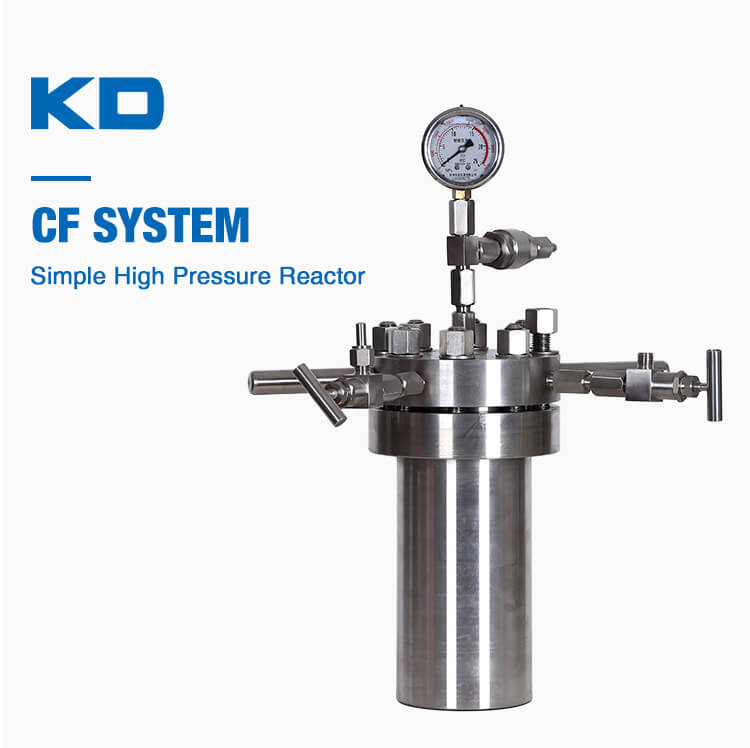
Lab Scale High Pressure Reactor Features:
FCF Series Lab Scale High Pressure Reactor:
1. It can fully stir and react various chemical materials under higher pressure, vacuum and temperature.
2. Static seal, no leakage, seal between the static ring of the reactor and the seat of the static ring, no O-ring, according to their respective structural characteristics, the contact stress increases with the working pressure, and the sealing performance is better. It is good under high pressure of;
3. The safety valve of the stainless steel lab scale high pressure reactor adopts a bursting diaphragm, which has a small error in the bursting value, fast instantaneous exhaust speed, and is safe and reliable;
4. The valves of the stainless steel lab scale high pressure reactor adopt needle valves, which are reciprocatingly closed, and the seal is reliable and durable.
5. The pressure gauge has good anti-vibration performance, can withstand the pulsation, impact and sudden unloading of the medium, and is suitable for places with severe environmental vibration.
6. Intelligent digital display temperature control meter, with automatic temperature control function, speed display and stepless speed regulation function, equipped with heating electric heating meter, motor ammeter, working time display meter.
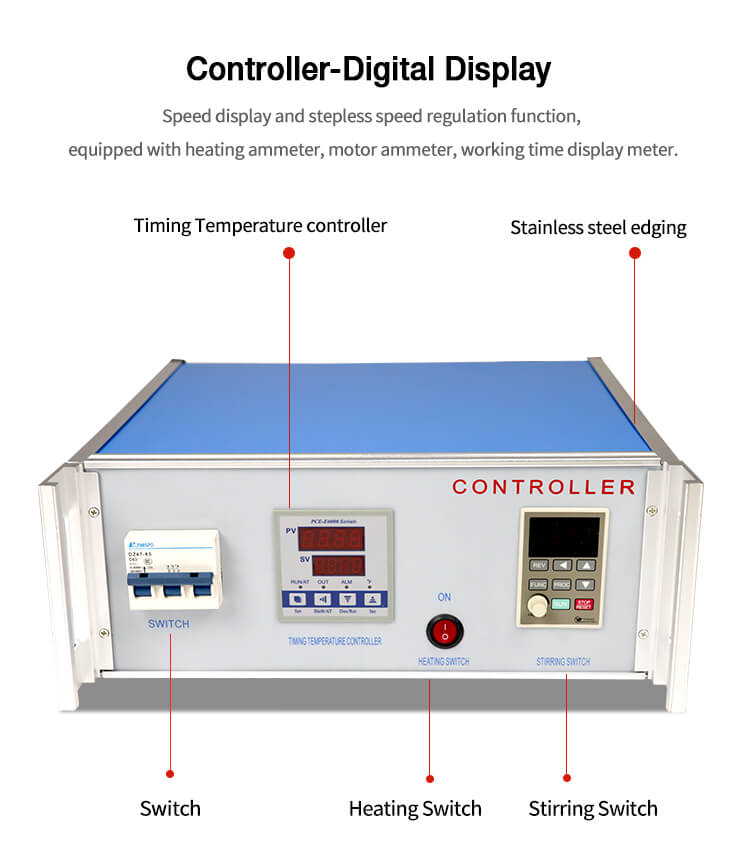
CJF Series Lab Scale High Pressure Reactor:
1. The static sealing structure is adopted, and the magnetic coupling is used to connect the agitator and the motor drive, which can completely solve the problem of sink leakage in the agitation, and make the whole medium and agitation parts completely in a sealed state for operation.
2. It is more suitable for stirring reaction of various flammable, explosive, highly toxic, precious media and other chemical media with strong penetration
3. Stirring method: It adopts a strong magnetic cylindrical rotary coupling structure, the stirring speed is 0~1000r/min, and the stirring volume can be adjusted according to the needs of users.
4. Electric heating, liquid heating, electric heating, and liquid heating can be provided according to customer needs.
5. The intelligent digital control instrument is used to collect and control the motor speed, reaction temperature and pressure in the pot, with high precision, simple operation and strong anti-interference ability.
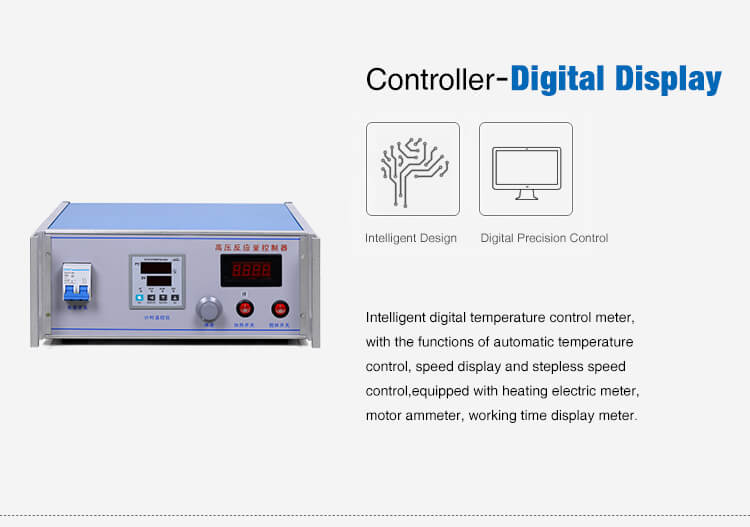
Simple Lab Scale High Pressure Reactor:
1. It can be placed in stainless steel electric blast drying furnace, constant temperature oil/water bath, low temperature tank, etc.
2. It has a good sealing effect. Small simple lab scale high pressure reactor system autoclave is suitable for mixing flammable, explosive, highly toxic, precious media and strong permeable chemical media.
3. The temperature can be controlled by PID temperature control system.
4. Cooling rate ≤5°C/min. The safe pressure is 22 MPa.
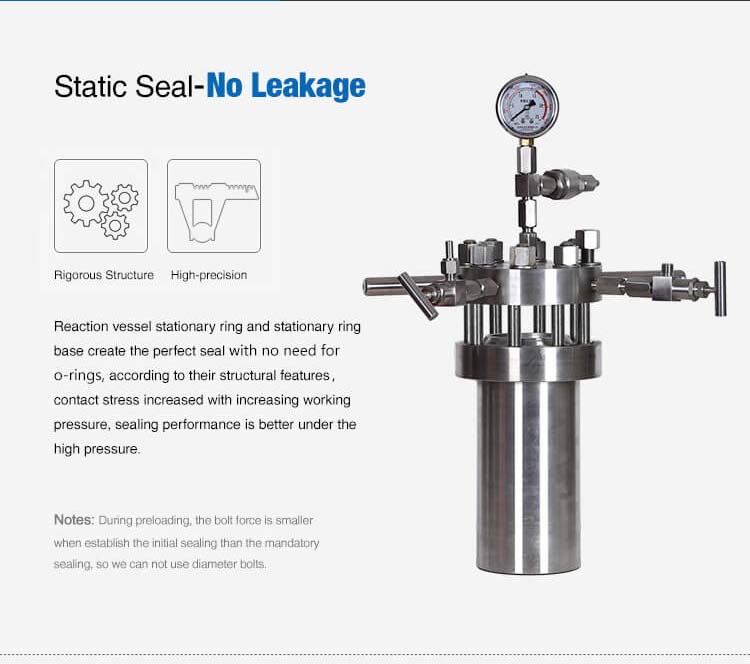
What Are the Advantages of Lab Scale High Pressure Reactors over Ordinary Reactors?
The lab scale high pressure reactor and the ordinary reactor belong to the category of the reactor, but the material composition of the two is not the same.
The body material of the lab scale high pressure reactor is mainly made of 1cr18Ni10Ti stainless steel, and titanium (TA2), nickel (Ni6) and composite steel plates can be made according to different media requirements. The body structure has flat cover, convex cover and closed type with manhole. The opening of the reaction kettle body and the kettle cover can be designed according to the user's requirements; the heating methods include jacketed steam, jacketed hot oil and electric heating, etc., which can be optionally selected by the user when ordering. For the internal surface of the kettle that requires polishing, it can achieve the above-mentioned mirror polishing level. For high-viscosity materials, it can be processed into a conical bottom, which is convenient for discharging and cleaning.
The materials of ordinary reactors generally include carbon-manganese steel, stainless steel, zirconium, nickel-based (Hastelloy, Monel) alloys and other composite materials. The reaction kettle can be made of stainless steel materials such as SUS304 and SUS316L. Agitators include anchor type, frame type, paddle type, turbine type, scraper type, and combined type. The rotating mechanism can adopt cycloidal pinwheel reducer, stepless variable speed reducer or frequency conversion speed regulation, etc., which can meet the special requirements of various materials. response request.
Common reaction kettle sealing devices can adopt mechanical seals, packing seals and other sealing structures. Heating and cooling can use jacket, half pipe, coil, Miller plate and other structures. The heating methods include: steam, electric heating, heat transfer oil, to meet the needs of different working environments such as acid resistance, high temperature resistance, wear resistance, and corrosion resistance. Craft needs. Moreover, it can be designed and manufactured according to the user's process requirements.
Precautions for the Use of Lab Scale High Pressure Reactors:
1. Sealing Performance
The autoclave is a precision equipment. The sealing ring adopts the contact sealing form of the cone surface, and the purpose of sealing is achieved by tightening the main bolts to make them compress each other. Therefore, special protection must be given to the sealing cone to avoid damage caused by various collisions. When installing the cover, first place the reactor body, and then carefully install the cover on the kettle body at a fixed position. When tightening the main bolts, they must be tightened diagonally and symmetrically for several times. Evenly, the kettle cover is not allowed to tilt to one side to achieve a good sealing effect, and the specified tightening torque should not be exceeded to prevent the sealing surface from being squeezed or accelerated wear. All threaded connections need to be coated with oil or oil mixed with graphite during assembly. If the sealing surface is damaged, it needs to be reprocessed to restore good sealing performance.
2. Sealing Operation
The air inlet and the exhaust valve are sealed with a needle valve. When closing, you only need to turn the valve needle slightly to press the tight surface to achieve a good seal. Excessive force is prohibited to avoid damage to the sealing surface.
3. Temperature Rise and Pressure Test
Before use, the autoclave should be heated and pressurized for a tightness test. Air and nitrogen can be used as the test medium, but inert gas is preferred. Oxygen or other flammable and explosive gases are strictly prohibited. The temperature and pressure increase must be carried out slowly. The heating rate is not more than 80 degrees per hour. During the pressure test, connect the inlet valve of the autoclave to the compressor (or high-pressure pump) with a connecting pipe. The pressure increase must be carried out in stages, with 20% of the working pressure as the interval, and stay for 5 minutes for each step up, and stay for 30 minutes when it reaches the test pressure, and check the sealing condition. The test pressure is 100-105% of the working pressure. If a leak is found, the pressure should be lowered first, and then the nuts and joints should be properly tightened. It is strictly forbidden to tighten the nuts and joints under high pressure.
4. Cooling Process
Rapid cooling and rapid heating are prohibited during the reaction process to prevent excessive temperature stress from causing cracks in the kettle body. After the reaction is over, cool down first, and cool it with water (exothermic reaction) or air cooling, then release the high-pressure gas in the kettle to reduce the pressure to normal pressure, and then unscrew the bolts symmetrically and evenly. In the process of opening the lid, special attention should be paid to protecting the sealing surface, and the kettle lid should be lifted evenly to avoid damage to the sealing ring of the kettle lid and the kettle body due to collision.
5. Subsequent Processing
After each operation, the residue on the kettle body and the lid should be removed. All sealing surfaces on the autoclave should be cleaned frequently and kept dry. Hard objects or soft objects with rough surfaces are not allowed to clean.
Maintenance Method of Lab Scale High Pressure Reactor:
1. In the process of use, the regulations on cooling, oil filling, etc. should be strictly followed, and the maintenance and maintenance of the lab scale high pressure reactor should be done well.
2. You should regularly check whether each pipe fitting and fastener is loose and tight, and check whether each instrument is malfunctioning.
3. Clean the small lab scale high pressure reactor every time you finish the experiment. When cleaning, do not touch or scratch the sealing surface. If there is dirt on the sealing surface, you should use the corresponding cleaning agent, and use Wipe clean with a soft cloth.
4. When not in use, it should be kept clean without stains or solvent residues, and the bolts and valves should be kept loose.
5. During daily use, it should be operated strictly according to the working pressure and working temperature marked on the product nameplate, so as to avoid danger.
6. When all the valves of the lab scale high pressure reactor are in use, the valve stem (needle) should be slowly turned, and the cover should be pressed tightly to achieve the sealing effect. It should also be turned slowly when closing to avoid damage to the sealing surface.
Why Choose Us
Professional reactor equipment manufacturer
ZZKD Machinery Equipment Co., Ltd. is a family integrating production and trade. Our main product is laboratory reactor equipment. Lab scale high pressure reactor is one of our main products for sale. Our lab scale high pressure reactor models are: FCF series of lab scale high pressure reactors, CJF series of high-pressure stirred autoclaves and simple lab scale high pressure reactors. At the same time, we can also customize according to your needs. The company has been established for more than ten years, providing equipment solutions for tens of thousands of enterprises and individuals at home and abroad, and has won unanimous praise from domestic and foreign customers.
Fast delivery
We have warehouses in Los Angeles in the United States, Valencia in Spain, and Thailand. We can choose the nearest warehouse for delivery according to the customer's geographical location, ensuring that the customer receives the goods quickly.
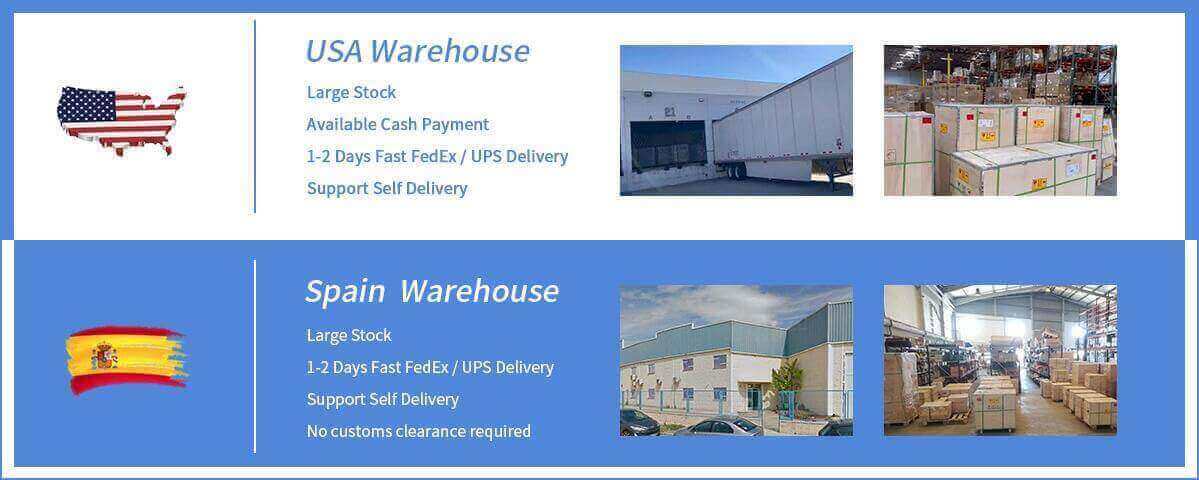
Perfect after-sales team
We provide a one-year warranty service for the products we sell. We have a professional after-sales team to deal with customers' after-sales problems, and can provide corresponding technical guidance through videos and other methods.
Parameter
FCF lab scale high pressure reactor parameter
Model | Capacity (L) | Setting Pressure (MPa) | Setting Temperature (℃) | Heating Power (kW) | Stirring Torque (N. cm) | Voltage (V/Hz) |
FCF-0.1 | 0.1 | 22 | 350 | 0.6 | 120 | 220 50/60 |
FCF-1 | 1 | 22 | 350 | 1.5 | 120 | 220 50/60 |
FCF-5 | 5 | 22 | 350 | 4 | 120 | 220 50/60 |
FCF-20 | 20 | 22 | 350 | 10 | 120 | 220 50/60 |
FCF-50 | 50 | 10 | 350 | 12 | 120 | 220 50/60 |
FCF-100 | 100 | 60 | 350 | 14 | 120 | 220 50/60 |
CJF lab scale high pressure reactor parameter
Model | Capacity (L) | Setting Pressure (MPa) | Setting Temperature (℃) | Heating Power (kW) | Stirring Torque (N. cm) | Voltage (V/Hz) |
CJF-5 | 5 | 22 | 350 | 4 | 120 | 220 50/60 |
CJF-10 | 10 | 22 | 350 | 7 | 120 | 220 50/60 |
CJF-20 | 20 | 22 | 350 | 10 | 120 | 220 50/60 |
CJF-30 | 30 | 22 | 350 | 12 | 120 | 220 50/60 |
Simple high pressure reactor parameter
Model | Capacity(L) | Pressure(MPa) | Material |
CF-0.025 | 0.025 | 22 | 304L/316L |
CF-0.05 | 0.05 | 22 | 304L/316L |
CF-0.1 | 0.1 | 22 | 304L/316L |
CF-0.2 | 0.2 | 22 | 304L/316L |
CF-0.25 | 0.25 | 22 | 304L/316L |
CF-0.3 | 0.3 | 22 | 304L/316L |
CF-0.5 | 0.5 | 22 | 304L/316L |
CF-1 | 1 | 22 | 304L/316L |
CF-3 | 3 | 10 | 304L/316L |
CF-5 | 5 | 10 | 304L/316L |
CF-7 | 7 | 10 | 304L/316L |
CF-10 | 10 | 22 | 304L/316L |
CF-20 | 20 | 22 | 304L/316L |
FCF lab scale high pressure reactor parameter
Model | Capacity (L) | Setting Pressure (MPa) | Setting Temperature (℃) |
FCF-0.1 | 0.1 | 22 | 350 |
FCF-1 | 1 | 22 | 350 |
FCF-5 | 5 | 22 | 350 |
FCF-20 | 20 | 22 | 350 |
FCF-50 | 50 | 10 | 350 |
FCF-100 | 100 | 60 | 350 |
CJF lab scale high pressure reactor parameter
Model | Capacity (L) | Setting Pressure (MPa) | Setting Temperature (℃) |
CJF-5 | 5 | 22 | 350 |
CJF-10 | 10 | 22 | 350 |
CJF-20 | 20 | 22 | 350 |
CJF-30 | 30 | 22 | 350 |
Simple high pressure reactor parameter
Model | Capacity(L) | Pressure(MPa) | Material |
CF-0.025 | 0.025 | 22 | 304L/316L |
CF-0.05 | 0.05 | 22 | 304L/316L |
CF-0.1 | 0.1 | 22 | 304L/316L |
CF-0.2 | 0.2 | 22 | 304L/316L |
CF-0.25 | 0.25 | 22 | 304L/316L |
CF-0.3 | 0.3 | 22 | 304L/316L |
CF-0.5 | 0.5 | 22 | 304L/316L |
CF-1 | 1 | 22 | 304L/316L |
CF-3 | 3 | 10 | 304L/316L |
CF-5 | 5 | 10 | 304L/316L |
CF-7 | 7 | 10 | 304L/316L |
CF-10 | 10 | 22 | 304L/316L |
CF-20 | 20 | 22 | 304L/316L |

